Bukchon Hanok Village Seoul: Things to Do & More
What if I told you there’s a place in Seoul where time stands still? Bukchon Hanok Village is one of those magical spots where you can walk through history. It has over 600 years of history!
This charming neighborhood is filled with traditional Korean houses (Hanoks). The narrow alleys and beautiful rooftops will make you feel like you’ve stepped back in time.
In this blog, I’ll guide you through everything you need to know about visiting Bukchon Hanok Village.
From how to get there to the best places to stay, and things to do, I’ve got you covered.
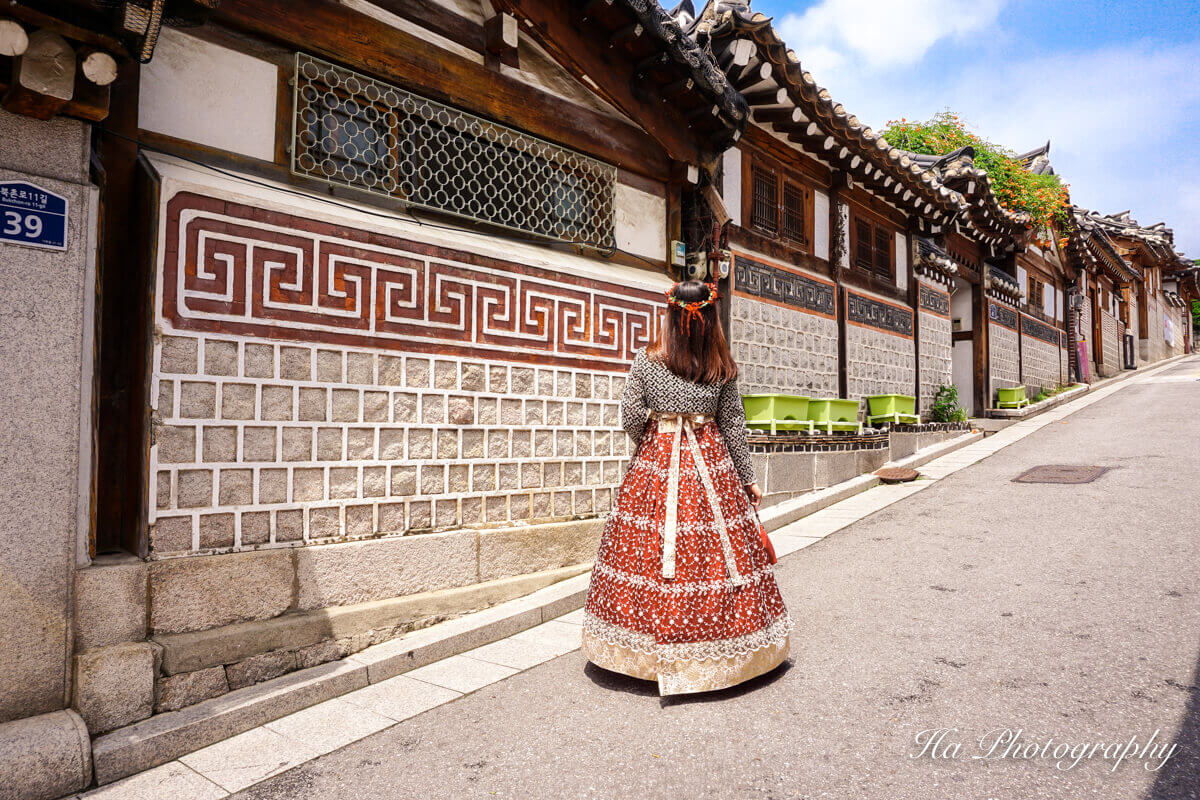
What to Know about Bukchon Hanok Village Seoul
Bukchon, which means ‘north village’ in English, got its name because it sits on the upper (north) side of Cheonggyecheon Stream and Jongno.
This village dates back around 600 years to the Joseon Dynasty. It was originally home to high-ranking officials and nobility.
Today, about 900 Hanoks still stand, offering a glimpse into Korea’s past.

I love this area and visit it whenever I’m in Seoul. Walking through Bukchon Village feels like stepping into a miniature Joseon-era Seoul, with its clay and stone houses and ancient tiled roofs.
Please note that Bukchon is a residential area. While it’s tempting to peek into every Hanok, many are private homes. Be respectful and avoid entering unless it’s clearly open to visitors.
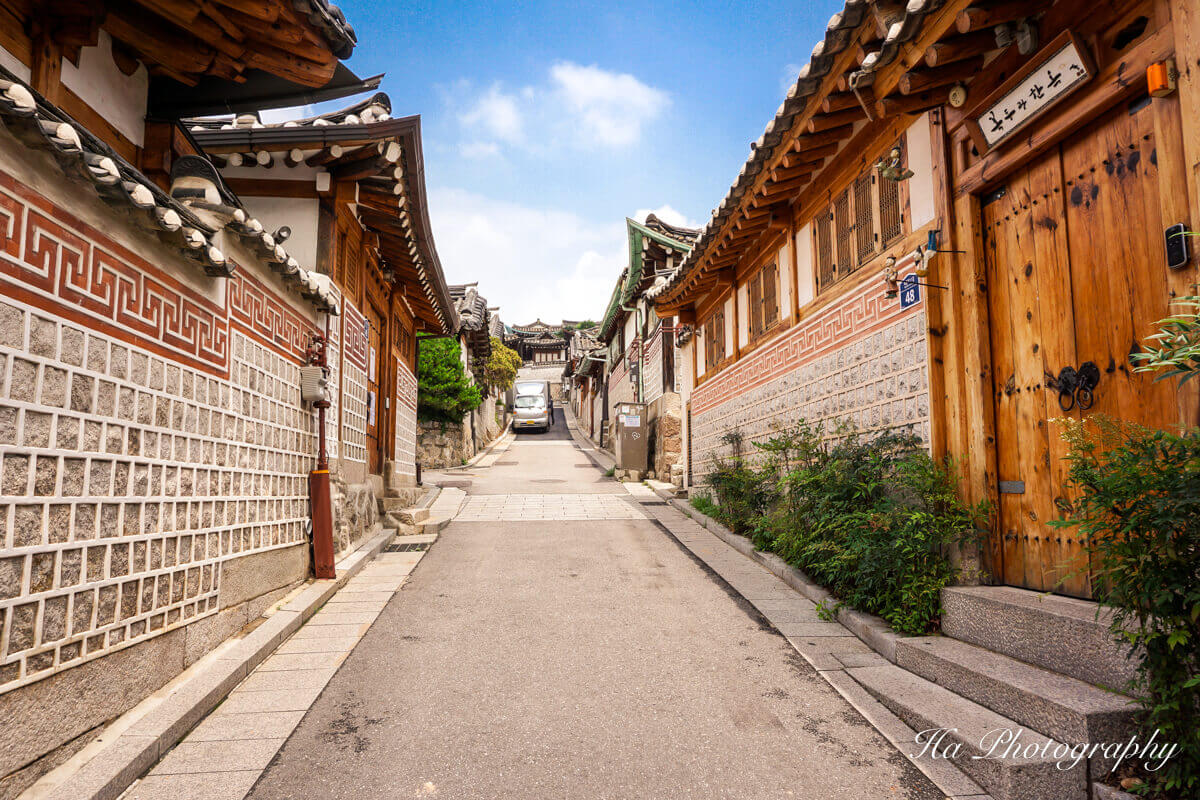
Free Entrance
Good news for travelers on a budget – Bukchon Hanok Village is free to enter. You can wander through the narrow alleyways without any admission fees.
However, some museums and cultural centers might charge a small fee for entry or special activities.
Visiting Hours
There are no set opening hours, but visiting during daylight is best to avoid disturbing residents.
How to Get to Bukchon Hanok Village
Getting to Bukchon Hanok Village is super easy.
Hop on the subway to Anguk Station on Line 3. Then, take Exit 3 to the Bukchon Traditional Culture Center, a perfect starting point for your adventure.
Tips: Navigating Seoul’s subway? Get a T-money card—it’s the easiest way to hop on and off!
Airport Transfer Options
Coming from Incheon International Airport to Bukchon Hanok Village? No problem!
You can take the AREX (Airport Railroad Express) to Seoul Station, then transfer to Line 1, and finally to Line 3 to get to Anguk Station.
Another good option is the Airport Bus, with routes 6011 and 6002 dropping you near Anguk Station.
For the most convenience, grab a taxi after you arrive at Seoul Station, though it’s a bit pricier. Just have the address ready in Korean to show the driver.
Where to Stay in Bukchon Hanok Village
If you’re planning to stay in Bukchon Hanok Village, here are three great options that offer a mix of traditional charm and modern comfort.
Gongsimga Hanok Guesthouse
This guesthouse is known for its warm hospitality and clean, comfortable rooms. You’ll love the serene garden and the authentic Korean breakfast served daily.
Don’t wait! Experience the beauty of Gongsimga Hanok Guesthouse on Booking.com or Agoda.com.
Bukchonae Hanok Guesthouse
Bukchonae Hanok Guesthouse is another excellent place to stay in Seoul, with a beautiful blend of traditional Korean architecture and modern amenities. This guesthouse features charming rooms with traditional decor and a peaceful courtyard.
Don’t miss out – book Bukchonae Hanok Guesthouse on Booking.com or Agoda.com.
Inwoo Guesthouse
The rooms at Inwoo Guesthouse are traditional yet comfortable, featuring ondol (floor heating) for a cozy stay in winter. It’s centrally located, making it easy to explore Bukchon Hanok Village and nearby attractions like Gyeongbokgung Palace.
Hanok Got Guesthouse
If you’re looking for an intimate vibe, Hanok Got Guesthouse is a great choice.
This Hanok features a beautiful courtyard and offers traditional ondol (floor) heating in winter and refreshing AC in summer. The location is excellent, with cool cafes and restaurants nearby.
Plan your Seoul retreat at Hanok Got Guesthouse – reserve on Booking.com.
Best Time to Visit Bukchon Hanok Village
Wondering when the best time to visit Bukchon Hanok Village is? Let me help you plan.
Spring and Autumn
The best times to visit Bukchon Hanok Village are spring (April to June) and autumn (September to November).
During these seasons, the weather is just perfect – not too hot or cold. Plus, the scenery is absolutely stunning.
In spring, you’ll see cherry blossoms and other flowers in full bloom. Autumn brings beautiful foliage with vibrant red, orange, and yellow leaves. Your photos will look amazing during these seasons.

Early Morning or Late Afternoon
If you want to avoid the crowds, try to visit early in the morning or late in the afternoon.
I’ve found that heading there around 8 AM gives you a peaceful experience as the village starts to wake up.
Late afternoons, around 4-5 PM, are also great. The light is softer, perfect for photography, and most tourists have left by then.
Weekdays vs. Weekends
Weekdays are generally less crowded than weekends. If you have the flexibility, plan your visit on a weekday to enjoy a more relaxed and serene atmosphere.
On weekends, the village can get busy with locals and tourists.
Best Things to Do in Bukchon Hanok Village
Bukchon Hanok Village is packed with cool things to do, and you’ll get a real feel for Korean culture and history. Here are some must-do activities in Bukchon Hanok Village.
1. Visit the Bukchon Traditional Culture Center
Start your visit at the Bukchon Traditional Culture Center.
This free stop offers great information about Hanok architecture and a walking map of the area. It’s a perfect place to get your bearings and plan your route through the village.
2. Stroll the Village in Hanbok
Have you ever dreamt of dressing up in a traditional Korean outfit? Rent a Hanbok and wander through the village.
The bright colors and elegant designs make for stunning photos. Plus, wearing a Hanbok gives you free entry to the palaces.
I tried it, and it felt like being part of a historical drama – such a memorable experience!
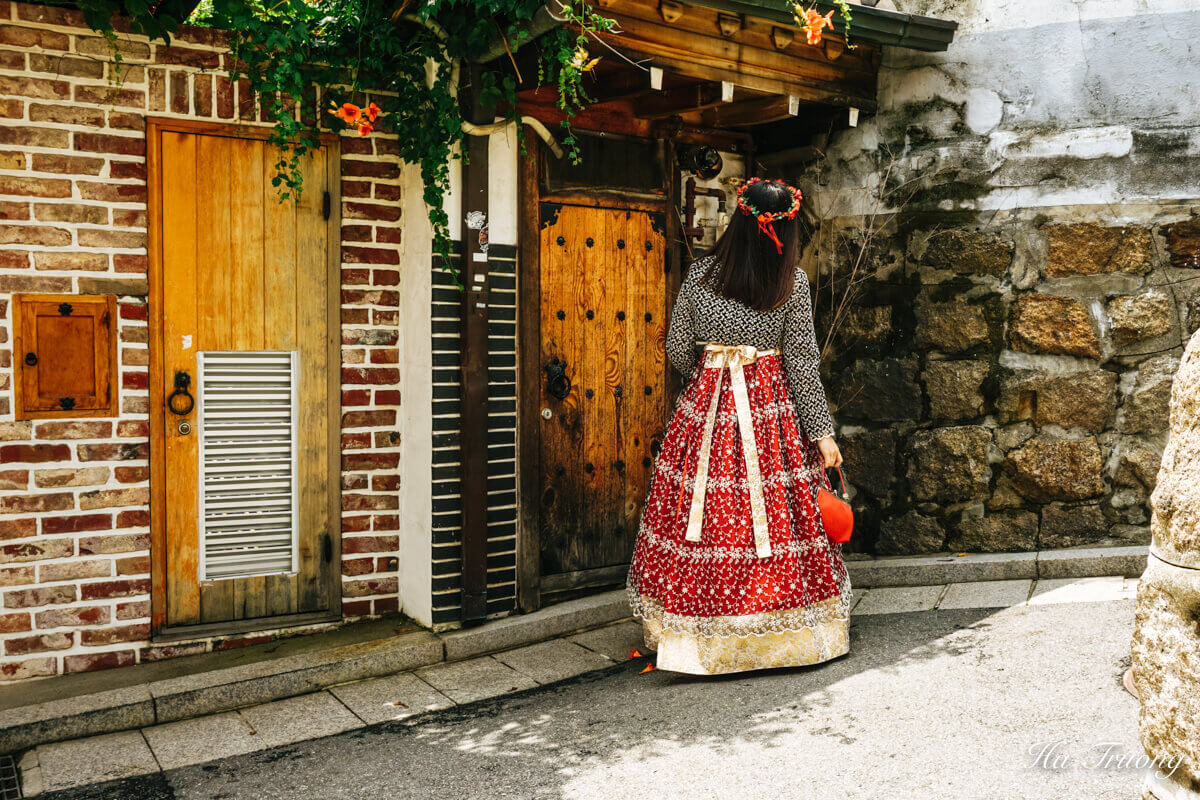
3. Enjoy a Panoramic View
For an Instagram-worthy shot, head up Bukchon Hanok Ilgil. This steep lane offers a breathtaking view of the Hanok rooftops.
The layers of tiles are mesmerizing, especially in the golden hour light. You’ll love the views – they’re incredible and make for the best photos.

4. Explore Cafes and Shops
Bukchon is full of surprises. Many Hanoks have been converted into cafes, cultural centers, and shops selling local handicrafts.
Spend some time strolling through the alleys, sipping tea at a traditional cafe, or picking up unique souvenirs. Every corner has a story to tell.
I write more about some of the best cafes in Bukchon Hanok Village below.

5. Visit Baek In-je House
You can also learn more about Korean culture at the Baek In-je House Museum. This well-preserved Hanok from the Japanese colonial era is open for visitors.
Take an English tour to hear fascinating stories of the aristocratic families who lived here. It’s a beautiful blend of history and architecture.
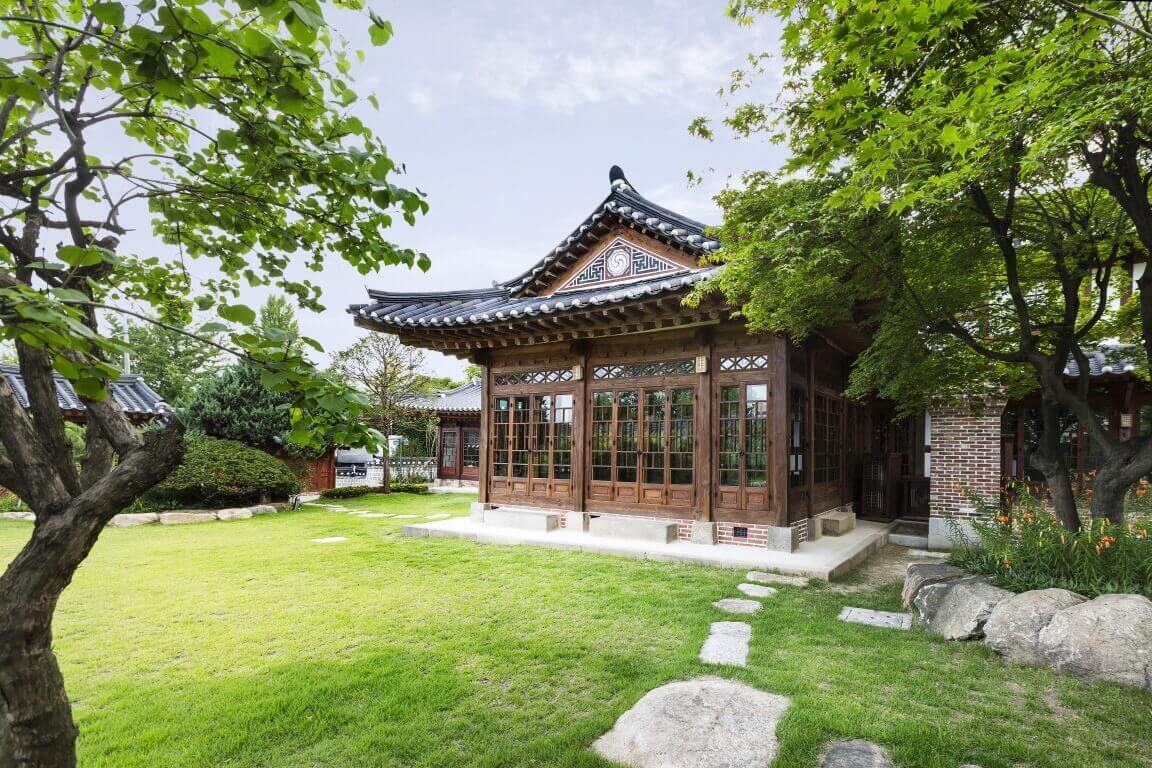
6. Experience Gold Leaf Printing
For a unique activity, try gold leaf printing at Kum Bak Yeon. You can sit in a traditional Hanok and learn the delicate art of applying gold leaf to silk.
You can choose to create a sash, bag, or bookmark. I made a beautiful bookmark that I still use – it’s a wonderful souvenir.
7. Visit the Traditional Korean Tea Institute
It’s one of my favorite things to do in Bukchon Hanok Village.
Here, you’ll learn about the delicate art of tea brewing, enjoy a calming tea ceremony, and even take part in a tea food-making course.
The tea ceremony is incredibly relaxing and insightful – a must-do for tea lovers.
8. Try Rice Wine Tasting
If you’re looking for unique experiences, don’t miss the rice wine tasting at Samhaesoju Brewery & Distillery.
You can meet master distiller Taeksang Kim and learn about the art of making traditional Korean liquor. The rice wine tasting was a highlight for me – so unique and delicious.
9. Visit Gahoe Museum
A hidden gem in Bukchon, the Gahoe Museum houses over 1,500 relics from Korea’s past. The museum focuses on folk paintings, shamanistic artifacts, and traditional crafts.
It also offers hands-on experiences like a T-shirt or fan painting. Great place to learn about Korean art and spirituality while enjoying a cup of green tea!
10. Dong-Lim Knot Museum
The Dong-Lim Knot Museum is a hidden gem in Bukchon.
This small museum showcases traditional Korean maedeup (knots) used in Hanbok, belts, and pouches. You can even make your own knotted design!
Best Cafes in Bukchon Hanok Village
Whether you’re looking for a spot to relax, enjoy a cup of tea, or snap some Instagram-worthy photos, Bukchon has plenty of options. Here are some of my favorite cafes in the area.
1. O’Sulloc Tea House Bukchon
For a relaxing break, stop by O’Sulloc Tea House Bukchon. This tea house offers a variety of Korean teas and delicious desserts.
The interior is beautiful, and the views of the Hanok rooftops are just stunning.
I highly recommend their green tea waffles – they’re the perfect treat after a long walk.
2. Greenmile Coffee
For a more modern vibe, check out Greenmile Coffee. This cafe is great for photos with its stylish interior and rooftop views. The coffee is excellent, and the snacks are delicious.
3. Cha Masineun Tteul
Tea lovers, this one’s for you. Cha Masineun Tteul is set in a traditional Hanok and offers a wide variety of teas.
Most seating is on the floor, with windows overlooking Gyeongbokgung Palace.
It’s one of my favorite tea houses in the area, and their in-house teas are simply delicious. The serene atmosphere makes it a perfect spot to unwind.
4. Coffee Mill
Coffee Mill is a cozy spot that retains much of the original Hanok structure, giving it a very authentic feel.
The cafe is known for its specialty coffees and homemade cakes. The rustic wooden beams and traditional decor make you feel like you’ve stepped back in time.
5. Layered
Layered is a famous bakery set in an old converted Hanok house.
It’s a great place to start your day with a coffee and a pastry before exploring Bukchon. Their pastries, especially the scones and cakes, are to die for.
Bukchon Hanok Village Outfits
Deciding what to wear for your trip to Bukchon Hanok Village can make a big difference in your comfort and overall experience. Here are some tips:
1. Dress for the Season
- Spring (April to June): Light layers are your best friend. Think comfortable jeans or trousers, a T-shirt, and a light jacket or sweater. Spring mornings and evenings can be cool, but the afternoons are usually mild and pleasant.
- Summer (July to August): Seoul can get quite hot and humid in the summer. Opt for breathable fabrics like cotton or linen. Shorts, skirts, and light dresses are great options. Don’t forget your hat, sunglasses, and sunscreen.
- Autumn (September to November): This is one of the best times to visit Bukchon. Layers are key here as well. Start with a base layer like a t-shirt or long-sleeve shirt, and add a light jacket or cardigan. The fall colors are beautiful, so you’ll want to be comfortable while exploring.
- Winter (December to February): Winters in Seoul can be pretty cold, so bundle up. Wear a warm coat, hat, gloves, and scarf. Thermal layers under your clothes can also help keep you warm. Comfortable boots are a good choice for walking around in the cold.

2. Comfortable Shoes
Bukchon Hanok Village is full of narrow, cobblestone streets and steep hills. Comfortable walking shoes are a must.
Sneakers, flat sandals (in the summer), or low-heeled boots (in the winter) will keep your feet happy as you explore.
3. Hanbok Rental
One of the unique experiences in Bukchon is renting a Hanbok, the traditional Korean dress. There are plenty of rental shops in the area where you can pick out a beautiful Hanbok to wear while you stroll through the village.
4. Bag for Essentials
A small backpack or a crossbody bag is perfect for carrying your essentials. It will keep your hands free to take photos and navigate the charming streets of Bukchon.
Make sure it’s big enough to carry water, snacks, your phone/ camera, and any souvenirs you pick up along the way.
Nearby Attractions
While Bukchon Hanok Village is amazing, there are several nearby attractions you shouldn’t miss.
1. Gyeongbokgung Palace
Just a short walk from Bukchon, Gyeongbokgung Palace is one of Seoul’s most iconic landmarks.
Built in 1395, it was the main royal palace of the Joseon Dynasty. You can spend hours exploring the beautiful grounds, grand halls, and serene gardens.
I love the changing of the guard ceremony at the main gate – it’s a colorful and fascinating glimpse into Korea’s royal history.
2. Changdeokgung Palace and Secret Garden
Another gem nearby is Changdeokgung Palace, famous for its stunning architecture and the Secret Garden.
This UNESCO World Heritage site offers a more intimate palace experience with lush gardens and historical buildings.
The Secret Garden, or Huwon, is a peaceful escape with ponds, pavilions, and ancient trees. Guided tours are available, but you’ll need to get the Secret Garden ticket in advance.
3. Insadong
For a mix of traditional and modern Korean culture, head to Insadong. This lively district is known for its antique shops, art galleries, and traditional tea houses.
It’s a great place to pick up unique souvenirs, from handmade crafts to Korean calligraphy. Be sure to try Korean street food or visit a traditional restaurant to experience the authentic taste of Korea.
4. The National Museum of Modern and Contemporary Art (MMCA), Seoul
Not far from Bukchon, the MMCA Seoul has a fascinating collection of contemporary Korean and international art.
The museum’s exhibits range from traditional Korean art to modern and experimental pieces. You’ll love it!
5. Namsangol Hanok Village
If you loved Bukchon Hanok Village, check out Namsangol Hanok Village next! Located at the foot of Namsan Mountain, this spot has five beautifully restored Hanok houses from the Joseon Dynasty.
You’ll see how different social classes lived back then. There are also fun cultural activities like knot-tying, calligraphy, and making Hanji (Korean paper). The gardens are perfect for a relaxing stroll with a traditional pavilion and serene ponds.
Final Thoughts
With its beautifully preserved Hanok houses, vibrant cultural activities, and charming cafes, Bukchon Hanok Village offers a unique glimpse into Korea’s rich heritage.
Whether you’re wandering the narrow alleyways, trying your hand at traditional crafts, or enjoying a cup of tea with a view, Bukchon has something special for everyone.
If you enjoyed learning about Bukchon, there’s so much more to discover in Seoul.
From its historical palaces and bustling markets to its modern art scenes and delicious cuisine, Seoul is a city that effortlessly blends the old with the new.



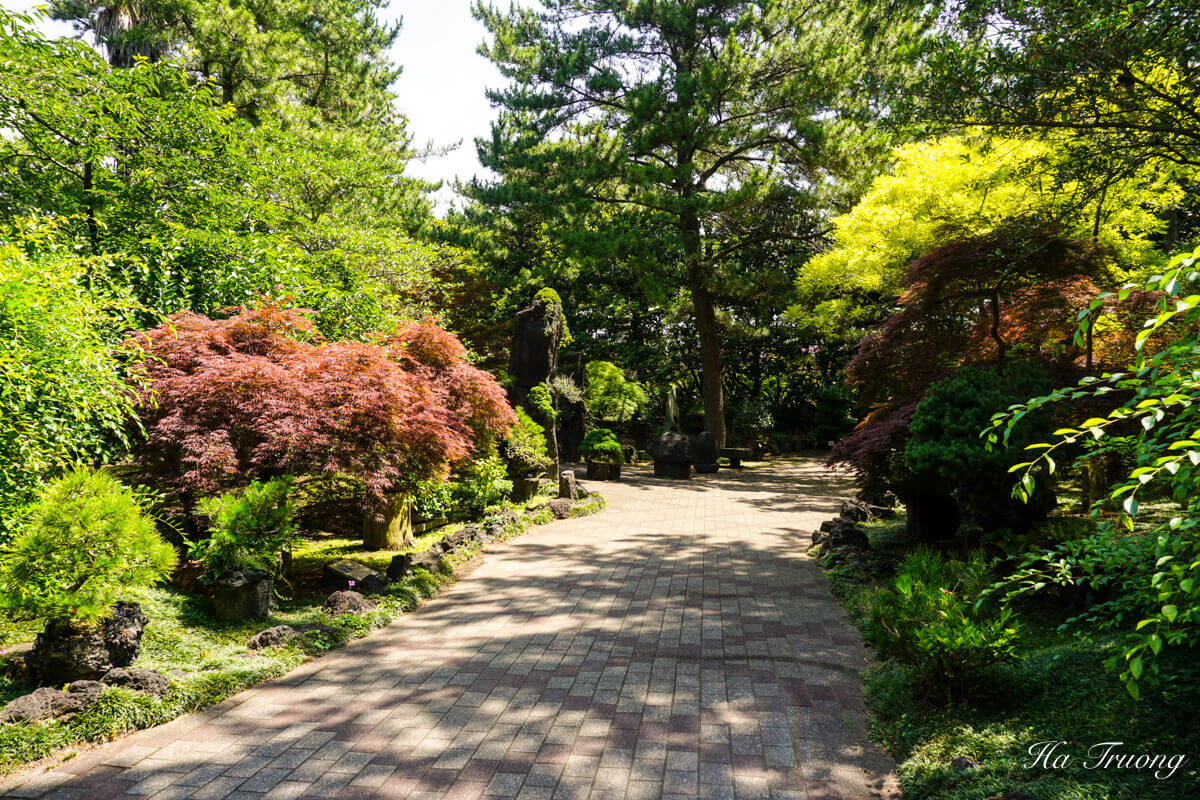
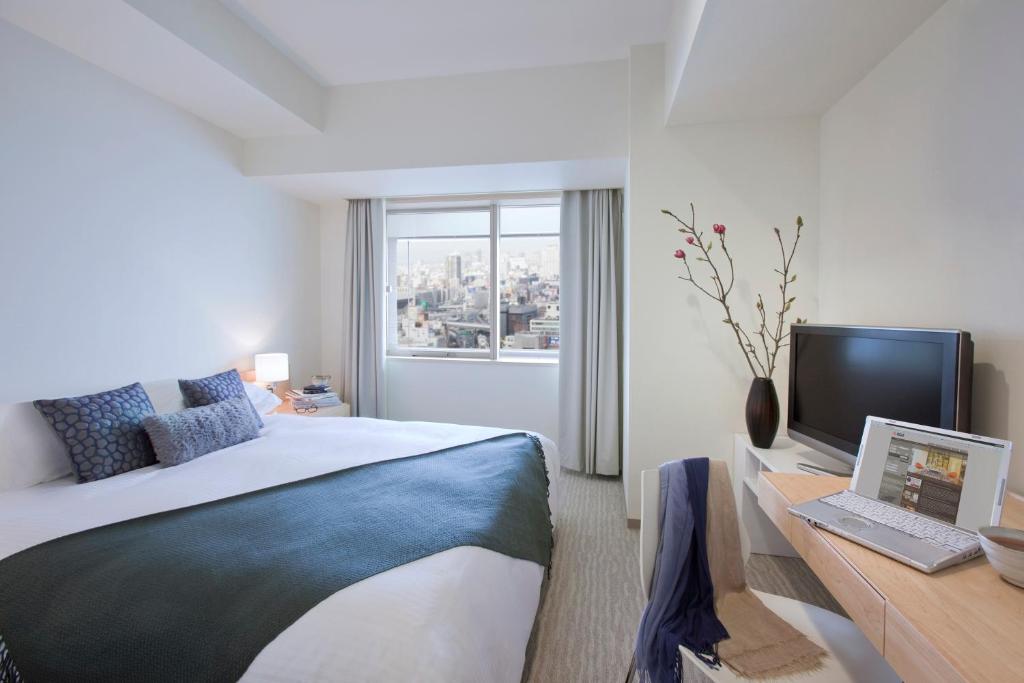

Wow, 900 traditional houses is an enormous amount! The architecture is so beautiful. I’d also love to take a craft-making class after strolling through the village. Seoul has been on my travel list for a while, so I’m glad I found out about Bukchon Hanok Village!
I love architecture! I would love to go see some of the shrines.
We had a very busy day when we visited Seoul. But we missed the Bukchon Hanok Village on that first trip. It does look like a colorful spot to learn more about the history of Korea and its traditions. It would be lovely to just wander and take in the house designs. That panoramic view would be worth the climb up the hill.
I remember seeing my sister’s pictures from Bukchon Hanok Village in a hanbok. Like you mentioned above, I think it’s a smart idea to rent the hanbok when visiting this village. The village’s architecture amazes me. I hope to get to visit this village in the future and rent the couple-themed hanbok. It will be fun.
I am recommending this to my daughter and her husband. They thoroughly enjoyed a heritage village in Japan, renting kimonos for a day. I am sure they will also enjoy Bukchon.
Hi there, thank you for this insightful article. Do you know if we can explore Bukchon from the top of the hill and then walk down (by taking a cab first)? Or is the only option from Anguk Station then walk up the hill? Thank you.
Hi,
I saw cars around the area, so probably you can take a cab up the hill. The streets in Bukchon Hanok are quite small and pretty easy to walk, so I find most travelers prefer walking up the hill. But the choice is yours.